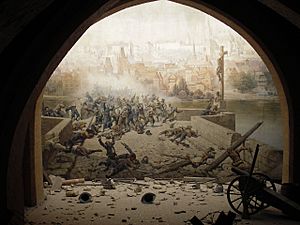Battle of Prague (1648) facts for kids
Quick facts for kids Battle of Prague |
|||||||
|---|---|---|---|---|---|---|---|
| Part of the Thirty Years' War | |||||||
 Swedes on the Charles Bridge. A diorama created in 1891 by brothers Karel and Adolf Liebscher depicts the highlights of stubborn defense of right-bank Prague by students led by the Jesuit Jiří Plachý |
|||||||
|
|||||||
| Belligerents | |||||||
| Commanders and leaders | |||||||
|
|
|
||||||
| Strength | |||||||
| c. 7500 soldiers (unconfirmed), plus 6000 reinforcements led by Charles X Gustav of Sweden | c. 2000 soldiers, plus local militia and university students | ||||||
| Casualties and losses | |||||||
| 500 dead, 700 wounded | 219 dead, 475 wounded | ||||||
The Battle of Prague was the very last fight of the Thirty Years' War. This long war had lasted for three decades. The battle took place in Prague between July 25 and November 1, 1648.
At this time, leaders were already talking about peace. They were working on the Peace of Westphalia treaty. Even so, the Swedish army decided to launch one last attack. Their main goal was to steal the amazing art collection from Prague Castle. This collection belonged to Emperor Rudolf II. The Swedes loaded the stolen art onto barges and sent it to Sweden.
The Swedes held the castle and the western side of the Vltava river for several months. They stopped attacking the eastern side of the city when they heard the peace treaty was signed. However, they stayed in Prague until September 30, 1649. This battle was the final major clash of the Thirty Years' War. It happened in the same city where the war had started 30 years earlier.
Contents
Prague Under Attack: The Final Battle
General Hans Christoff von Königsmarck led the Swedish army into Prague. The city was defended by Governor Rudolf von Colloredo. He was a very experienced military leader. Colloredo had fought in many important battles before.
Swedish Surprise Attack
The Swedes launched a sudden night attack. They managed to capture the western side of the Vltava river. This included Prague Castle and the areas called Hradčany and Lesser Town. These parts of the city were very rich. The Swedish soldiers completely looted them.
Two days later, the Swedes tried to cross the Charles Bridge. They wanted to enter the Old Town on the eastern side of the river. But Colloredo's soldiers fought them off. The Swedes could not get across the bridge.
Fighting on Both Sides
Later, a third Swedish army arrived. It was led by Prince Carl Gustaf. On September 25, all three Swedish armies attacked Prague. They attacked from the west, trying to cross the Charles Bridge again. They also bombed the city from the north. The biggest attacks came from the eastern plains. They aimed for the New Town.
These attacks were stopped. This was thanks to Governor Colloredo's skill. His soldiers fought bravely. The local citizens also helped defend their city. University students even formed their own volunteer groups. These groups were called the Academic Legion. They were led by a Czech Jesuit priest named Jiří Plachý. A German priest and lawyer, Hans Georg Kauffer, also helped lead them.
The Looting of Prague Castle
Since the Swedes could not capture the eastern part of the city, they focused on what they had. They looted Prague Castle and the palaces and monasteries nearby. Some historians believe this was their main goal all along.
Emperor Rudolf II's Treasures
Many valuable items were taken from Prague. These treasures had been collected by Emperor Rudolf II. Famous items like the Codex Gigas (a huge medieval book) and the Codex Argenteus (a silver Bible) were taken. You can still find some of these items in Sweden today. For example, some statues by Adrien de Vries are at Drottningholm Palace.
Later, Christina, Queen of Sweden (who ruled from 1632 to 1654) took the best artworks with her. After she died in 1689, these artworks were sold off. Many of Rudolf's paintings ended up in the United Kingdom. A Swedish list from 1652 shows that 472 paintings came from Prague.
Remembering the Battle
After the battle, people wanted to remember what happened.
Marian Column
In the Old Town Square, a Marian column was built. This monument was put up to celebrate Prague being saved from the Swedes.
Colloredo's Tomb
A monument was also built on Colloredo's tomb. It is in the Church of the Maltese Order in Prague. This monument honors his victory over the Swedes. The German words on it say:
HIER RUHT RUDOLF GRAF COLLOREDO K.K. FELDMARSCHALL UND MALTHESERORDER GROSSPRIOR Vertheidiger der Alt und Neusstad Prags gegen die Schweden Geb. am 2 Nov. 1585 Gest. am 27 Jan. 1657.
This means: "Here lies Rudolf, Count Colloredo, Imperial and Royal Field Marshal and Grand Prior of the Order of Malta, defender of the Old and New Town of Prague against the Swedes. Born November 2, 1585 Died January 27, 1657."
Charles Bridge Inscription
On the Charles Bridge tower, there is a Latin message from the 1600s. It says:
SISTE VIATOR, SED LUBENS, AC VOLENS UBI SISTERE DEBUIT, SED COACTUS GOTHORUM, AC VANDALORUM FUROR
This means: "Stop here, traveler, and be happy: you can stop here willingly, but unwillingly were stopped the Goths (Swedes) and their Vandalic fury."

